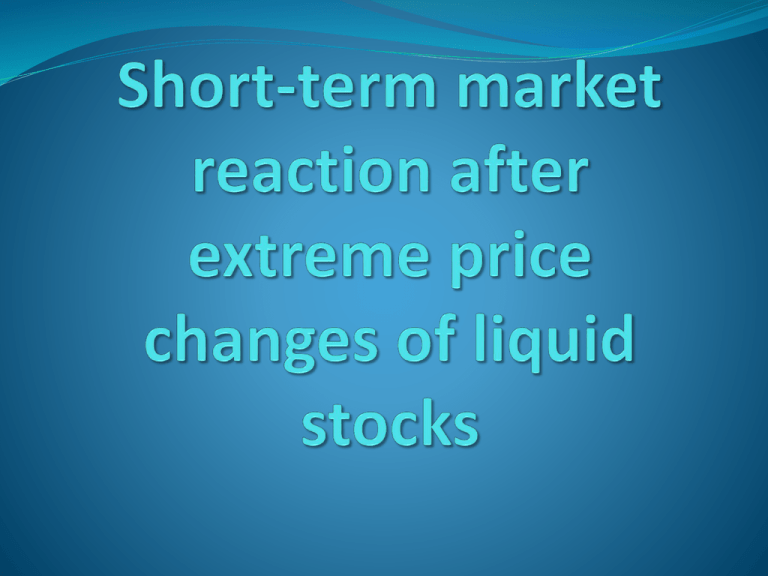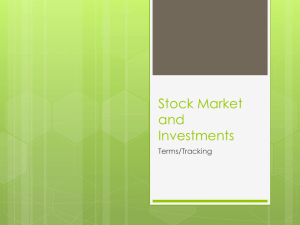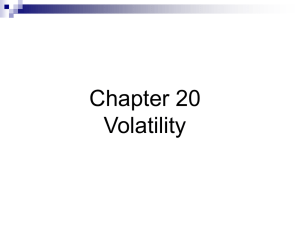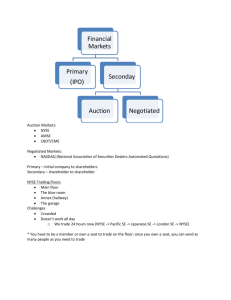price change
advertisement

Introduction price evolution of liquid stocks after large intraday price change Significant reversal Volatility and volume stay high NYSE-widen bid-ask spread NASDAQ-almost constant bid-ask spread NYSE versus NASDAQ Able to adjust for dividend & stock split No dividend & stock split info Includes all transactions and the best bid-ask spread Computer basedoccasionally single transactions filed outside bid-ask spread Trading data from 09301600 Trading data from 09301600 Defining Large Price Changes Absolute Filter Intraday price change > 2-6% within 10-120 mins Relative Filter Price move exceeding 6-10 times the normal volatility during that time of the day Omit first 5mins and last 60mins of trading Calculation of Average Calculate average minute volatility, trading volume and bid ask spread based on 60 pre-event trading days • Compare volatility, volume and spread with pre-event minute average. Beta Measure of volatility of a portfolio in comparison to the market Calculated using daily stock prices and index changes of the 60 pre event trading days Beta may change after large price shocks Post-event abnormal return calculated using beta computed using 60 post-event trading days Results-Intraday Price Reaction Significant reversal 10-60mins after event Faster reversal for price increases Price reversal is bigger for decreases after 30-60mins interval Abnormal return = Raw return – (beta * index return) AR and RR very close Price Reversal NYSE price evolution NASDAQ price evolution Stability of Price Reversal Size of filter does not affect existence of overreaction 60-minute long price drops exceeding 2-6% and 6-10 times the average 60-minute volatility Length of price drop affects validity of results 10-minute to 120 minute long price drops exceeding 4% and 8 times the average “Intraday reversal puzzle” Chartist traders overreact irrationally compared to fundamentalist traders, which lead to pricing error that is later reversed. Natural consequence of the existence of informed and uninformed traders. Linear relationship between size of original price drop and size of rebound. 60-min raw returns after intraday 60-min price drops exceeding 2-6% and 6-10 times average 60-min volatility 60-min raw returns after intraday 10-120-min price changes exceeding 4% and 8 times the average 10-12-min volatility Evolution of volatility and volume Transaction dollar volume increase sharply at even up to 8 9 times of its value during pre-event days. Volume and volatility decrease only very slowly after the event. Decrease of post-event excess volatility well fitted by power-law, but not volume. Volatility from extreme events decay faster than autocorrelation, possible due to large shocks being more likely to be exogenous than all fluctuations. Bid-ask spread stays virtually unchanged on the NASDAQ but increases to 6 times its pre-event value on NYSE. Evolution of volatility and volume on NYSE and NASDAQ Decay of Volatility on NASDAQ Decay of Volume on NASDAQ Evolution of bid-ask spread on NYSE and NASDAQ Profitability of Contrarian Strategies Contrarian trading strategy yields significant abnormal profit on NASDAQ during the post-event 30-60 min by buying at ask price at min 0 and selling at bid at min 30. Profits are lower or insignificant on NYSE due to wide bidask spread. Not true that profits on NASDAQ can only be acquired by traders who are amazingly fast. Profits limited by number of shares available at the best bid and ask price but significantly larger than 0. Further studies should examine exact profitability taking into account transaction costs and costs of monitoring. Contrarian Trading Strategy Strategy when an investor attempts to profit by going against the trend Used the direction of the trend to identify profitable opportunities. Buy low, sell high Decision-making process goes against human emotion Intraday profitability of Contrarian Strategy Future Possible Research Apart from NYSE and NASDAQ, which other stock exchanges would be suitable for this strategy and why? To consider the use of volume as an additional filter? Is it worth it? Transaction costs Cost of monitoring stocks In 1963-67, significant rebound of 1.87% expected on 1st 3 days. 1987-1991, rebound of 0.06%-Implication that overreaction is a sign of market inefficiency. Future? Risks involved-dead cat bounce Conclusion Significant overreaction on NYSE and NASDAQ. Stability analysis confirms findings. Call to attention “intraday reversal puzzle” due to behavioral trading Different behavior of bid-ask spread on NYSE and NASDAQ due to different market mechanisms Volatility , volume and bid-ask spread increase sharply at the event and stay significantly high long after price adjustment. Post-event decay of excess volatility welldescribed by power-law. Intraday contrarian trading strategies are profitable in the event of extreme price changes. Exact profitability of such strategy should be studied further.






